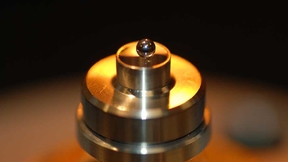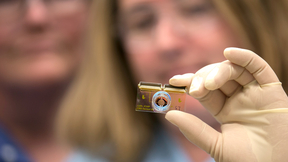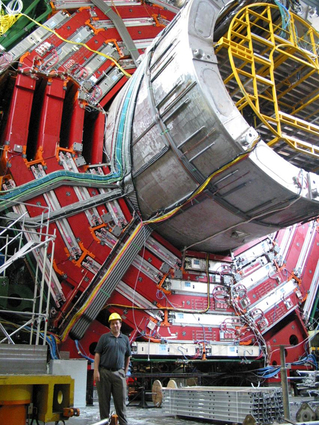New accelerator is smash hit with Lab scientists
In the start of an experiment physicists believe will help resolve basic questions about the nature of the universe, the first proton beam was circulated Wednesday through the 17-mile-long Large Hadron Collider, the world’s most powerful particle accelerator.
Located at the CERN particle physics research center near Geneva, Switzerland, the Large Hadron Collider (LHC) is a multi-national project supported by the U.S. Department of Energy’s Office of Science and the National Science Foundation among other institutions, including the Laboratory. (See the USLHC press release on the Web. )
Circulation of the first beam is the inaugural step on the way to the goal of colliding high-energy beams in the LHC accelerator’s detectors. Scientists believe the analysis of experiment data may reveal: unknown particles and their nature; the origins of mass; the nature of dark matter; and even uncover new dimensions of space.
"The Large Hadron Collider opens up a new era in physics and we are excited to be among the collaborators contributing to LHC detector technology and experiments," said Doug Wright, LLNL High Energy Physics Group leader. "This facility will remain at the center of international research efforts in physics for the foreseeable future, and will no doubt give us a completely new understanding of our universe.
Lab scientists are collaborators on the Compact Muon Solenoid (CMS) experiment, a 20,000-ton apparatus designed and constructed over 15 years in concert with the LHC accelerator. The CMS detector is searching for the elusive Higgs particle and "supersymmetry" from proton collisions. The Lab also is contributing to the data analysis to these efforts. In addition to Wright, contributors include career Lab physicists David Lange and Jeff Gronberg, and postdocs Jonathan Hollar and Bryan Dahmes, currently stationed at CERN.
"We have a horse in the race for both the Higgs and Supersymmetry discoveries," Wright said. Lange is leading a project funded by the Laboratory Directed Research and Development (LDRD) program to search for the Higgs. Predicted to exist by the widely accepted Standard Model of particle physics, the Higgs boson would help explain why particles with no mass can cause matter to have mass. Supersymmetry is "an elegant idea" that solves the most pernicious problems in particle theory by postulating the existence of "super" partners for all known particles and is the subject of an LDRD effort led by Gronberg.
Down the road, the LHC also will be used to conduct heavy ion physics as part of the ALICE experiment, accelerating heavy ions such as lead atoms. Lab scientists are contributing to the preparations for these experiments with DOE-funded support from LLNL physicists Ron Soltz, Jason Newby and Andrew Glenn.
Livermore physicists are involved with the "high level trigger," the last link in the chain of the accelerator’s CMS detector system. The trigger identifies the "interesting physics" from the enormous quantities of background activity, according to Lange.
"There are no computers fast enough to write all the data," Lange said, explaining that the trigger is an electronic device designed to capture specific event data, which includes thousands of CPUs to process data in real time to decide on the subset of data to retain for analysis by researchers. "Processing the vast quantities of data is like drinking from a fire hose; without a trigger that can quickly pick out the interesting events, the new physics signals are lost from the detector."
What is discovered at the LHC is just the beginning, says Wright. In order to understand what is observed in the messy environment of the hadron collider, work has already begun to design a precision electron-positron linear collider, where a novel idea based on LLNL laser technology may play a crucial role.
"We have been data starved for a long time," says Wright, "and we know that our current theory is fundamentally flawed. We are now finally entering an energy regime in which nature will give us a glimpse of the solution."
Contact
Don Johnston[email protected]
Tags
Laboratory Directed Research and DevelopmentFeatured Articles









